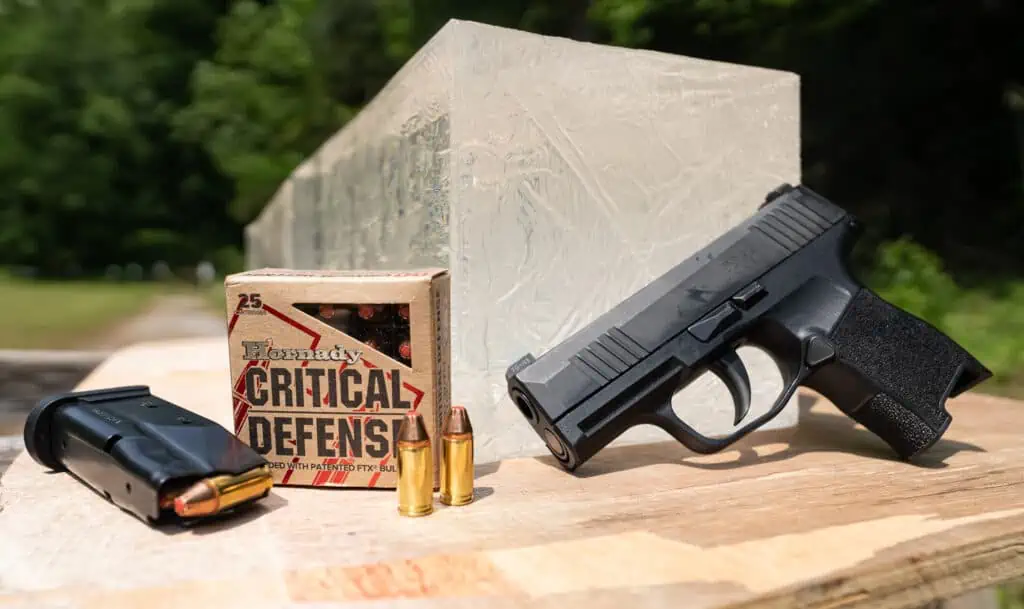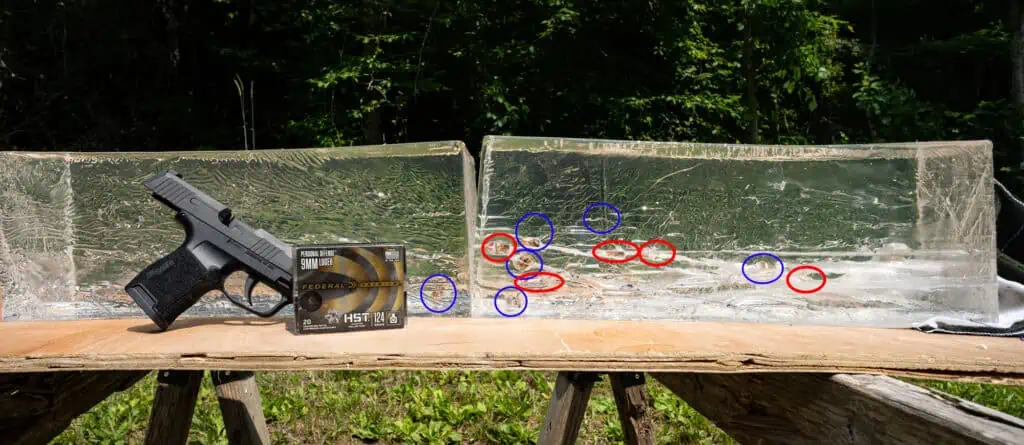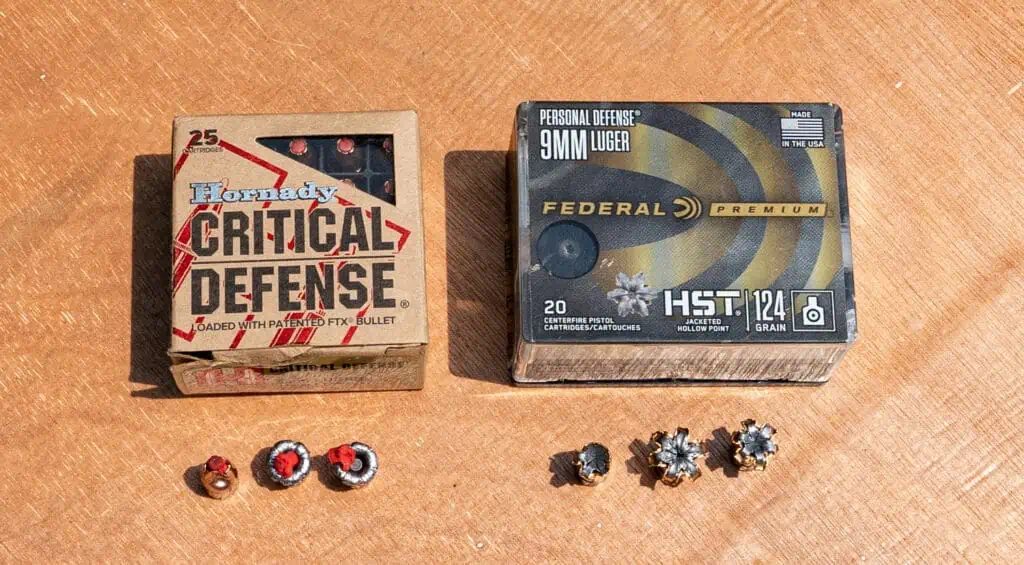As many experienced self-defense and duty carriers will tell you, it’s not the gun that does the essential work, it’s the ammo. (In all reality, it’s both, functioning in tandem, that matters most, but we digress.)
Your self-defense ammunition choice is one of the most important decisions you’ll make as a gun owner. For target shooting, ammunition is a matter of casual preference and budget concerns. For self-defense, it’s a decision that could save your life and lives of others.
Two of the most popular self-defense rounds are the HST line from Federal Premium and Hornady’s Critical Defense. Both of these brands, which come from well-established, highly-regarded ammo companies, are trusted by conceal-carry users all across the country. While similar in many ways, they also have clear differences that impact how they perform in a magazine, in the chamber, and when they are fired.
Testing Hornady Critical Defense vs Federal HST
We’ll get into finer details about what makes these ammo choices different but let’s get right to the million dollar question first: What’s better for self-defense?
We took a Sig P365 pistol that’s a fairly common choice for civilian shooters and tested each round in Clear Ballistics ballistic gelatin. For our testing we used Hornady 115 Grain Critical Duty ammo and stacked it up to the best-selling Federal 9mm 124 grain HST.
From a distance of 10 yards, we registered five shots into the gelatin through a 4-layer fabric barrier. This is similar to what the Federal Bureau of Investigation does to evaluate its ammunition.

Gel Test Results for the Ammo
In our testing, both rounds performed pretty well appear to be decent options in 9mm.
If you use the FBI’s guidelines as your barometer, the Federal HST proved to be a better choice for self-defense with this 3.1″ barrel.
Average Penetration
Hornady Critical Defense: 11.5″
Federal HST: 13.4″

The Hornady Critical Defense rounds are circled in red, the Federal HST in blue.
Expansion for both rounds was somewhat spotty. In the case of the Critical Defense rounds, two of the bullets didn’t offer much expansion in the gel. In the case of the HST, two of those bullets also remained largely unexpanded.
Average Expansion:
Hornady Critical Defense: .49″
Federal HST: .6″

So, why did these rounds perform differently? Let’s dive in to see how Hornady and Federal produce each round and how the materials and make-up of the ammo itself vary with these two options.
Test Summary: Hornady Critical Defense vs Federal HST
Both rounds performed adequately well for shooters interested in self-defense. That said, the majority of self-defense trainers and experts would likely prefer the Federal HST based on its larger expansion and deeper penetration through the gelatin. These characteristics are beneficial when trying to neutralize an attacker.
Keep in mind, these tests were conducted with just one pistol and just one barrel. A full-frame pistol with a longer barrel, may give you different results. (As might a shorter pistol.)
Hornady Critical Defense
Hornady Critical Defense is a personal and home-defense line of ammunition that, according to the company’s marketing material “maximizes the potential of a hollow point bullet.”
The most noticeable feature of the Critical Defense is the Flex Tip bullet. This bullet starts with a lead-core round wrapped in a copper jacket, the standard design for all hollow-point ammunition. What makes it unique is the ballistic tip (colored red for easy identification) that is loaded into the hollow-point cavity at the front of the round. Essentially, it’s a hollow point stuffed with a polymer tip.

The design of the bullet is intended to cut through barriers like cloth and heavy clothing while maintaining its shape. The thought is that the red tip helps the bullet cut through initial barriers, then allows for expansion once it reaches the body of a target.
The product line also uses nickel-plated cases, which are believed to cycle with greater reliability. (There is supposedly less friction for nickel than brass.) It’s also loaded with low-flash propellants that will do less to disrupt your vision at night.
Hornady has made Critical Defense available in a surprising variety of cartridges. The most popular self-defense rounds are present, including 9mm Luger, .38 Special, .357 Magnum, and .40 S&W, but it also includes rare and less-used cartridges.
Cartridges available for Critical Defense include:
- .25 Auto
- .32 Auto
- .32 H&R Magnum
- .327 Federal Magnum
- .380 Auto
- 9mm Luger
- .38 Special (+P Available)
- .357 Magnum
- 9x18mm Makarov
- .40 S&W
- .410 shot
- .44 Special
- .45 Auto
- .45 Colt
Italics = Available for both Critical Duty and Federal HST.
Federal HST
Available from Federal, one of the nation’s top ammo manufacturers, the HST is also a hollow point cartridge designed for self-defense purposes. This round uses a “specially designed” hollow point that resists plugging as it passes through barriers. “Plugging” in this case refers to cloth or other material plugging the hollow point and preventing the bullet from expanding.
Much of Federal’s marketing for the HST line focuses on weight retention. They claim that the rounds have “nearly 100% weight retention,” which means the bullet maintains its overall mass and does not splinter, fracture, or break apart. This is a critical aspect for bullet penetration, as weight retention generally results in deeper penetration.
This cartridge also uses a nickel-plated case that improves, at least in theory, cycling from the magazine to the chamber. Federal says they load the ammo with a “high-performance primer” to deliver superior functionality and performance in semi-automatic pistols.
Like the Critical Duty, Federal has made the round available in most of the popular self-defense cartridges. You’ll find 9mm Luger, .40 S&W, .45 Auto, and the new and increasingly popular .30 Super Carry.
- .30 Super Carry
- 9mm Luger (+P Available)
- .357 Sig
- .40 S&M
- 10mm Auto
- .45 Auto (+P Available)
Italics = Available for both Critical Duty and Federal HST.
What Do Critical Duty and HST Have in Common?

There are many similarities between these two brands. The biggest similarity is that they both feature a hollow-point bullet. Although the Critical Defense is stuffed with a Flex Tip, they both have expanding projectiles designed for maximum wound diameter.
They also have nickel-plated cases, which have many advantages. Nickel-plated cases are better at resisting corrosion and many believe they deliver an advantage in cycling.
The two rounds also share a few cartridges. If you own a handgun that loads 9mm Luger, .40 S&W, or .45 Auto (which combined make a significant portion of the handgun-ammo industry), you can choose either of these options.
How are They Different?
While the similarities are obvious, the differences are just as clear. Most noteworthy is the use of a ballistic tip in the Hornady Critical Defense, a feature that is not seen in the Federal HST. What impact this makes on ballistic performance is debatable, but it’s one aspect that clearly separates the two.
Cartridge availability is also a major difference for these two. While both are available in the three popular handgun rounds (9mm Luger, .40 S&W, .45 Auto), there are many cartridges that are unavailable in Critical Defense or HST. And these are not rare, novelty cartridges either. As examples, the .30 Super Carry, is only available for HST, while the .380 Auto is only available in Critical Defense. (It’s almost as if Hornady and Federal agreed to a separation of cartridges. There’s enough 9mm business to share, but you get the 10mm Auto and the .30 Super Carry, we get the .380 Auto and .357 Magnum…)
This difference in cartridge availability could guide your decision regardless of which brand or manufacturer you prefer. For example, if you have a 10mm Auto handgun, you will only be able to load HST. (Although Critical Duty, a similar brand from Hornady, is available for 10mm Auto.)
Find Reliable Ammo for Personal and Home Protection
Whether you load Hornady Critical Defense vs Federal HST in your pistol, you’ll get a trusted cartridge that is known for excellent ballistic performance and reliability.
Visit our site today and place your order for high-quality ammo at a price that fits your budget! You can see our line-up of Federal ammo here and Hornady by clicking here.






